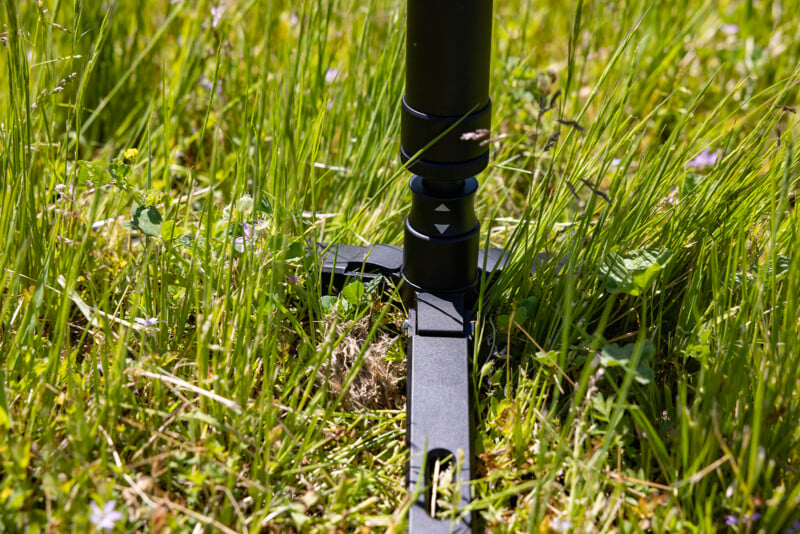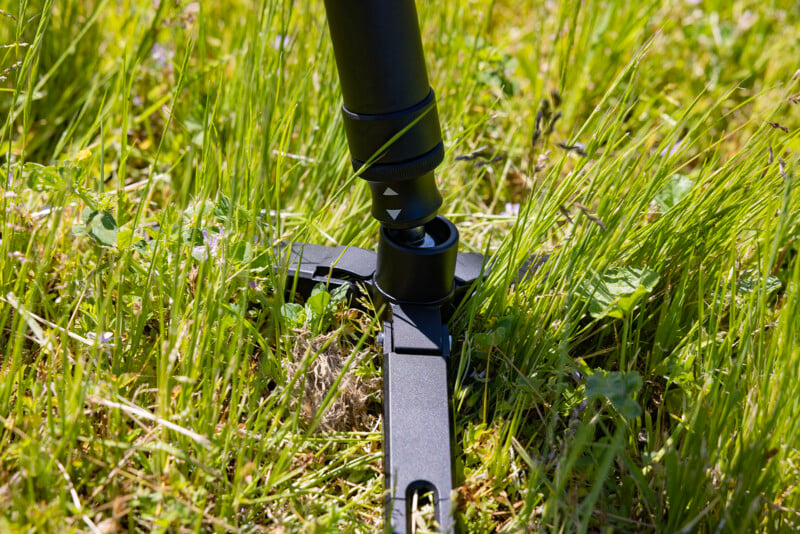ProMaster’s Air Support Monopod Puts a Premium on Speedy Deployment
![]()
ProMaster’s Air Support Monopods are designed with a primary focus on speed and ease of use. Forgoing typical twist or clip locks, the system instead uses a single-button system that’s way simpler.
Monopods aren’t the most exciting, but they are hugely important to certain types of photographers and filmmakers. Personally, I use a monopod in one of two situations: when I’m photographing sports or birds, or when I’m shooting video in the field. In both cases, I’m looking for basically the same general features.
Signs of a Good Monopod
For one, the monopod can’t weigh very much. In either of my aforementioned cases, my camera rig itself is usually quite heavy. If it’s not a long, heavy telephoto lens for capturing far-away subjects, it’s a video camera rigged with audio equipment. If I’m using a monopod, I don’t want that to be a source of even more weight.
![]()
I also want the monopod to be able to stand on its own. I’ve put up with simple monopods that are basically a stick with a tripod head, but often I’m using more than one camera or at the very least I need both of my hands every now and again. I’m not a fan of having to set my monopod and camera down on the ground, so I prefer ones that have a foot of some sort and are capable of holding their own weight.
ProMaster Air Support Monopod: Design and Build Quality
ProMaster’s Air Support Monopod fits both of these “must haves” for me. For starters, the unit itself is very light even though it’s not made out of carbon fiber. There are two versions of the monopod, each with slightly different specifications. Both use an all-aluminum build, but the Air Support Monopod 431 weighs four pounds, four and a half ounces and compacts down to just a bit more than two feet long. When fully extended, it grows to 63 and a half inches tall and can support a camera that weighs up to 15 pounds, seven ounces. The Air Support Monopod 425 is slightly smaller and weighs two pounds, half and ounce, extend to a maximum height of 62 and three-quarter inches, and folds down to exactly two feet tall. It can handle a maximum load of eight pounds, 13 ounces. The one pictured here is the larger 431 model.
![]()
To keep the monopod upright and stable, it has a three-leg, folding base that also has a ball joint that can be locked into place when not in use. The ball joint is especially useful since it allows me to adjust my angle and easily follow subjects without losing my stability and the fact that it locks in place means my camera can sit upright without my assistance and I don’t have to lay it on the ground. Even when locked, the monopod can pan side to side very easily and freely without the feet moving.


Overall, the general construction feels durable and high quality. On close inspection, I couldn’t find any weak points in the design, and everything other than the soft grip is made of aluminum. The screw for mounting your camera can be flipped around if you want to instead attach a ball joint or a video pan-tilt head.
![]()
Other than the fact it is well made, the ProMaster Air Support Monopod has one nifty trick that shows that the company put special emphasis on speed and ease of deployment.
ProMaster Air Support Monopod: Speedy Design
ProMaster says what separates its monopod from the rest is a single button press release mechanism. After pulling the monopod to a desired height, the button press release mechanism located near the monopod head lowers the monopod in one motion. ProMaster says this allows you to adjust your shooting position in seconds and, when you’re done shooting for the day, you can just press the release button to quickly compress the monopod back down to its smallest height for easy storage.
I’m not sure if this is a system ProMaster came up with or if it’s seen on other monopods on the market (based on its explanation ProMaster seems to indicate it’s an original concept), but regardless I am a fan. Any method that tries a new take on the old tripod designs and is successful at it I’m going to cheer because outside of a scant few examples, the stabilization market has been extremely stagnant for decades.
![]()
The release mechanism uses two buttons located opposite of each other. This design is smart, since you can’t accidentally disengage the quick release — you have to actively pinch both buttons together.
![]()
The only downside of this design is that the shaft doesn’t lock going the other way — since you deploy the monopod by pulling up on the shaft and it doesn’t lock in that direction, you can accidentally deploy it when traveling. I took the monopod with me on a plane and during the trip it did slightly pull out from its most compact size during the trip, but it wasn’t significant. In order to deploy it to any meaningful height, you really do have to take some effort to fully pull it out. So while it can accidentally deploy, it shouldn’t be a big deal.
I’m more than willing to make that minor tradeoff for the speed that I can get this thing up and running as well as collapsed back down. To me, that’s worth it.
ProMaster Air Support Monopod: Fast, Easy, and Sturdy
As I said, monopods aren’t overly exciting, so it’s really refreshing to see a design that tries something new or at the very least unusual. Even better, there wasn’t much sacrificed to get the new functionality, so the ProMaster Air Support Monopod doesn’t make you learn a new way to use something that might slow you down and attempt to erase years of muscle memory.
![]()
The ProMaster Air Support Monopod 431 is available for $120 while the smaller ProMaster Air Support Monopod 425 costs $100. Both are reasonably priced, especially considering the build quality and design, too, which is always a plus.
Welcome to a PetaPixel Showcase, in which our staff gives you a hands-on with unique and interesting products from across the photography landscape. The Showcase format affords manufacturers the opportunity to sponsor hands-on time with their products and our staff, and it lets them highlight what features they think are worth noting, but the opinions expressed from PetaPixel staff are genuine. Showcases should not be considered an endorsement by PetaPixel.